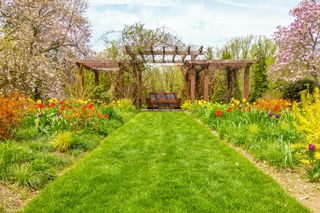Grief
Why Are Gardens So Good for the Soul?
Seven ways of finding comfort and healing in a garden.
Posted January 15, 2020 Reviewed by Gary Drevitch

When we’re wounded in body, mind, or spirit, we’re often drawn to the natural world as a place to heal. For some, it’s a walk in the woods or along the shore. For many of us, a garden is our place of healing.
“Gardens can aid in physical, mental, and emotional healing in myriad ways,” says Chris Fehlhaber, assistant horticulturist at Chanticleer Garden in Wayne, Pennsylvania.
I was surprised by these healing effects when I constructed my own garden a year ago. I was in the middle of a long bout with then-undiagnosed toxic mold illness and felt drawn to build a vegetable garden in my backyard—not because I expected it to fix what ailed me, but because I enjoyed gardening and needed more hobbies.
There was something about being outside that felt deeply life-giving, even in the dry 20-degree February air as I built the raised beds. I found myself easily letting go of my constant preoccupation with the mysterious symptoms that had limited my activities. As I filled the beds and knelt on the ground with my hands in the soil, my mind cleared and my spirit was refreshed.
Writer Margo Rabb experienced her own form of healing from prolonged grief in the garden that Fehlhaber tends, which she shared in her New York Times article, “Garden of Solace.” I spoke with the two of them on the Think Act Be podcast as we explored what gives gardens their healing power. Here are seven themes that emerged from our discussion.
You Can Be Yourself
In a world that encourages us to put on a façade, a garden is a refreshingly honest place. “One of the things we really like about plants is that they’re totally honest with us,” Fehlhaber sais. “A plant will tell you if it’s not getting enough sun or it’s getting too much water.”
The honesty we find in a garden encourages our own honesty and authenticity. “If everything around you is being honest and presenting themselves as they are, you let your own guard down,” Fehlhaber said. “As you drop your defenses, that can lead to healing.”
Part of being yourself is being free to feel what you feel. “For me, it was a place where sadness didn’t feel like something to be ‘fixed,’” Rabb said. “We want to believe that grief is something you get over, but you don’t really. It changes forms and it’s cyclical and it comes and goes, but you don’t ‘get over it.’ This was a place where you could feel sadness in all its complexity. I could feel those complicated feelings and just let them be.”
As we allow our defenses to drop and let ourselves be honest, we open to the truth of our experience and of who we are. What is a sanctuary if not a place to be yourself?
You Can Slow Down
When you enter a garden, time tends to slow down. Your mind and body relax as you step away from the daily bustle, and you can connect with your spirit. Gardens invite us to drop the constant doing and allow ourselves to just be.
“There’s a gentleness to gardens,” Rabb said, “and it’s an escape from the news and the violence that we’re constantly confronted with. It’s not a gentle world out there.” She found that Chanticleer Garden offered the space she needed to feel the grief of losing her mother 25 years earlier. The unhurried pace of being in a garden offers us the time that grieving requires.
“We don’t have many of these gentle spaces anymore,” Rabb said. “To come here where things are peaceful and gentle—it’s a sacred space.”
I felt that sense of consecration as I knelt in my own garden one day. What began as a posture to pull weeds was transformed into a sacred act, as though I were genuflecting to something greater than myself.
You Can Connect With Others, Including the Departed
Gardens can also serve as a conduit between us and other people. Even though we often don’t know the hands that built a garden, we feel the touch of humanity all around us through life in a garden. A garden may bear the mark of those who designed it and placed the plants and trees in the soil, even long after they’re gone.
Fehlhaber shared a personal account of how gardens can connect us with those who are no longer living. “My grandfather used to raise me up on his shoulders to smell the blossoms on a crabapple tree,” he said. “To this day I make a point of smelling them as often as I can every spring because they’re so ephemeral. And I feel as though I’m back up on his shoulders.”
You Can Receive Love
When you imagine a garden you may not think of love, but it’s a powerful healing force that gardens offer. A garden is built on love—not the cliché of pink and red hearts, but the fundamental life force that’s in every living thing. Connecting with that form of love can be a powerful part of healing.
Love in a garden comes through our sensory experiences rather than through words. “Plants are communicating with you in the language of the senses—sight, sound, touch, taste, and smell,” Fehlhaber said. “All plants have a lot to say if we take the time to understand them. They lack the ability to say it verbally, but isn’t love really just an expression of health and happiness?”
Love also emerges from the care that goes into a garden. “Any time you put your heart and soul into something, the love that underlies it can help with the healing process. That love and spirit are what resonate with people in a garden,” Fehlhaber said.
Rabb concurred. “You see how much has been poured into a garden, and then you receive that,” she said. “It’s like a relationship, almost like receiving a love letter.”
You Can Get Out of Your Own Head
One of the best parts of a garden is the welcome change of scenery, whether from being lost in thought or being glued to a screen. “Our worlds become small and insular when we’re dealing with something like grief,” Fehlhaber said, “and it’s easy to get lost in our own narratives. When you can let go of those thoughts and simply be present and engage with what’s around you, you notice how much life is happening that honestly has nothing to do with you.”
Life and death continually surround us in a garden. We can find comfort in knowing that these cycles continue, no matter what’s happening in our personal lives. “All the life you find in a garden will live and it will die, it will have good days and bad days just like we do,” Fehlhaber said. “A plant that looks fabulous one day will be dead the next. That’s life—that’s what happens. And that realization helps you know that it’s going to be okay.”
You Can Open to Change
Change is hard, especially when it’s unwelcome—the loss of a loved one, for example, or a decline in our health. These changes can feel like a departure from the way things “should be,” as we resist anything that upsets our world as we know it.
“Gardening is an affirmation that change is inevitable and okay,” Fehlhaber said. “It’s neither good nor bad—it simply is. With change comes the confirmation that life is finite, and will end as all seasons do.” As we accept the cycles of life and death in a garden, we can move toward acceptance of those cycles in ourselves and in those we love.
In the process, gardens remind us that change is not the end of the story. “Gardening affirms that life goes on, and will continue after and without us,” Fehlhaber said.
You Can Find Life in Death
Death is perhaps the hardest change to accept. Death feels so final and can seem like the opposite of life. But gardens can show us that death not only is a part of life but enables life. Dead plants and other organic matter are broken down by microorganisms and become the compost that gives life to the next season’s growth.
“The thing about gardens is that they’re quite literally built on death and decay,” Fehlhaber said. “That’s what helps form the soil that makes everything around us possible. So something that seems quite grim is actually providing the opportunities for all this life and enjoyment.”
Fehlhaber gave the example of late autumn, which is typically seen as a time of death and decay. “As gardeners we see this as the start of the new season because everything that’s happening now is what’s going to allow this garden to rise and be reborn next year. Death is everywhere in a garden, and it’s okay.”
“It’s a work of art that’s constantly living and dying in front of you,” Rabb added. “There’s something so beautiful and comforting in that.”
The complete conversation with Margo Rabb and Chris Fehlhaber at Chanticleer Garden is available here




